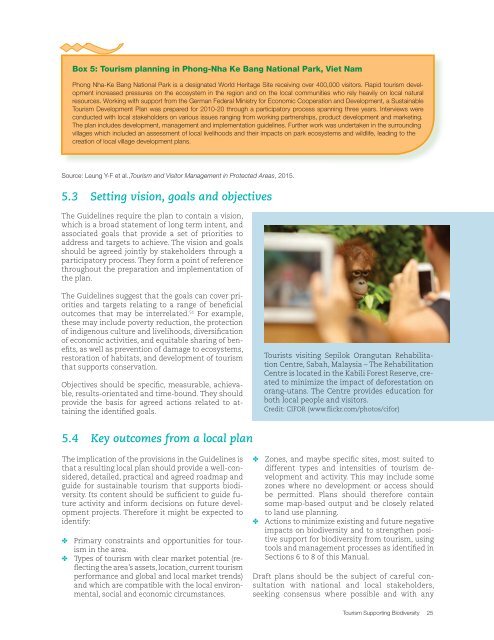1Tgjonb
1Tgjonb
1Tgjonb
You also want an ePaper? Increase the reach of your titles
YUMPU automatically turns print PDFs into web optimized ePapers that Google loves.
Box 5: Tourism planning in Phong-Nha Ke Bang National Park, Viet NamPhong Nha-Ke Bang National Park is a designated World Heritage Site receiving over 400,000 visitors. Rapid tourism developmentincreased pressures on the ecosystem in the region and on the local communities who rely heavily on local naturalresources. Working with support from the German Federal Ministry for Economic Cooperation and Development, a SustainableTourism Development Plan was prepared for 2010-20 through a participatory process spanning three years. Interviews wereconducted with local stakeholders on various issues ranging from working partnerships, product development and marketing.The plan includes development, management and implementation guidelines. Further work was undertaken in the surroundingvillages which included an assessment of local livelihoods and their impacts on park ecosystems and wildlife, leading to thecreation of local village development plans.Source: Leung Y-F et al.,Tourism and Visitor Management in Protected Areas, 2015.5.3 Setting vision, goals and objectivesThe Guidelines require the plan to contain a vision,which is a broad statement of long term intent, andassociated goals that provide a set of priorities toaddress and targets to achieve. The vision and goalsshould be agreed jointly by stakeholders through aparticipatory process. They form a point of referencethroughout the preparation and implementation ofthe plan.The Guidelines suggest that the goals can cover prioritiesand targets relating to a range of beneficialoutcomes that may be interrelated. 51 For example,these may include poverty reduction, the protectionof indigenous culture and livelihoods, diversificationof economic activities, and equitable sharing of benefits,as well as prevention of damage to ecosystems,restoration of habitats, and development of tourismthat supports conservation.Objectives should be specific, measurable, achievable,results-orientated and time-bound. They shouldprovide the basis for agreed actions related to attainingthe identified goals.Tourists visiting Sepilok Orangutan RehabilitationCentre, Sabah, Malaysia – The RehabilitationCentre is located in the Kabili Forest Reserve, createdto minimize the impact of deforestation onorang-utans. The Centre provides education forboth local people and visitors.Credit: CIFOR (www.flickr.com/photos/cifor)5.4 Key outcomes from a local planThe implication of the provisions in the Guidelines isthat a resulting local plan should provide a well-considered,detailed, practical and agreed roadmap andguide for sustainable tourism that supports biodiversity.Its content should be sufficient to guide futureactivity and inform decisions on future developmentprojects. Therefore it might be expected toidentify:✤Primary constraints and opportunities for tourismin the area.✤Types of tourism with clear market potential (reflectingthe area’s assets, location, current tourismperformance and global and local market trends)and which are compatible with the local environmental,social and economic circumstances.✤Zones, and maybe specific sites, most suited todifferent types and intensities of tourism developmentand activity. This may include somezones where no development or access shouldbe permitted. Plans should therefore containsome map-based output and be closely relatedto land use planning.✤Actions to minimize existing and future negativeimpacts on biodiversity and to strengthen positivesupport for biodiversity from tourism, usingtools and management processes as identified inSections 6 to 8 of this Manual.Draft plans should be the subject of careful consultationwith national and local stakeholders,seeking consensus where possible and with anyTourism Supporting Biodiversity 25


